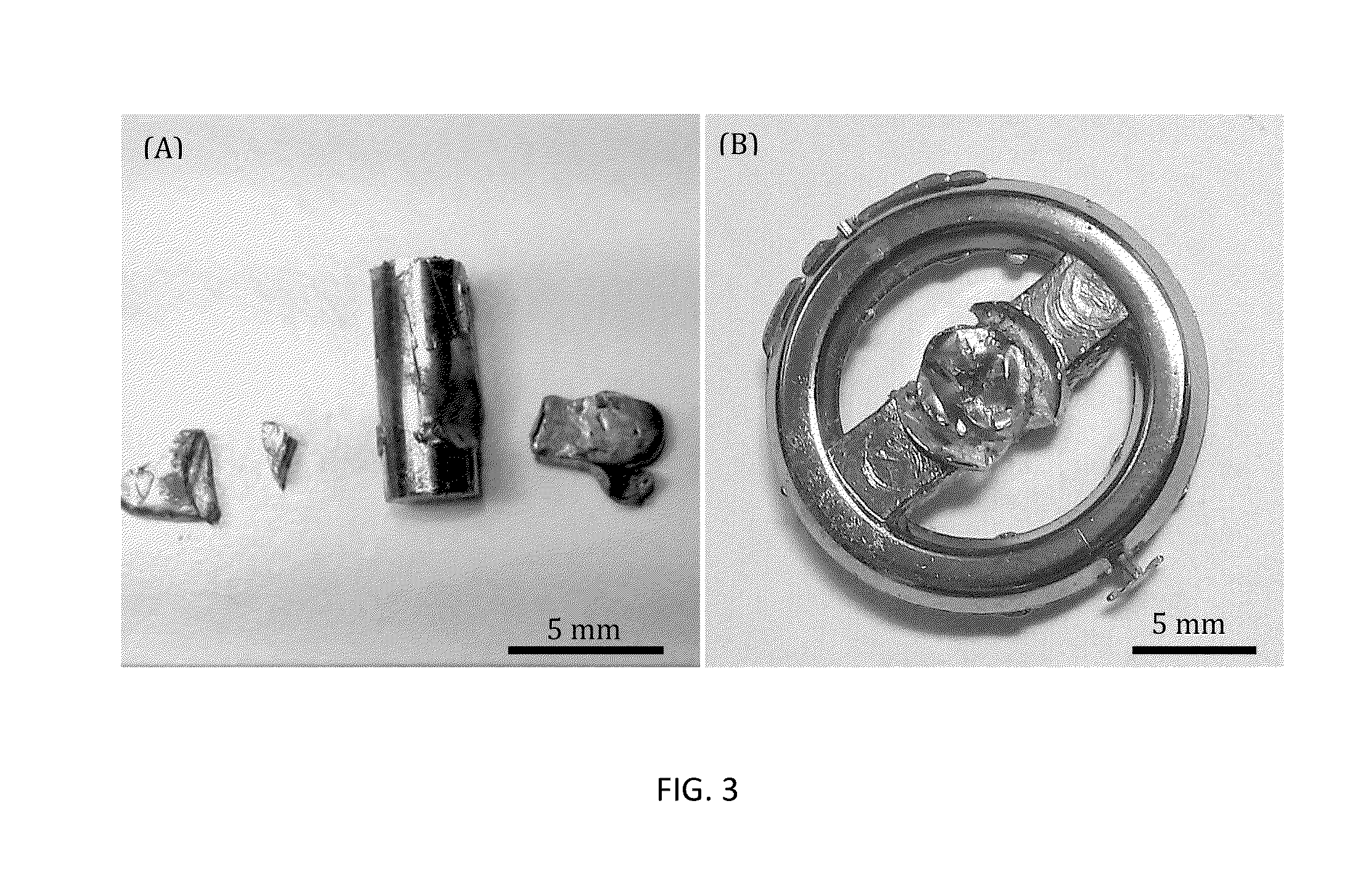Methods for shaping high aspect ratio articles from metallic glass alloys using rapid capacitive discharge and metallic glass feedstock for use in such methods
a technology of metallic glass alloys and feedstocks, which is applied in the field of methods and metallic glass alloy feedstocks, can solve the problems of releasing energy and corresponding sharp rise in temperatur
- Summary
- Abstract
- Description
- Claims
- Application Information
AI Technical Summary
Benefits of technology
Problems solved by technology
Method used
Image
Examples
example 1
Screening of Ni—Based Alloys
[0092]To explore the processing window and the RCDF shaping capabilities as a function of composition, the family of Ni—Cr—Nb—P—B glass-forming alloys disclosed in U.S. patent application Ser. No. 13 / 592,095, entitled “Bulk Nickel-Based Chromium and Phosphorus Bearing Metallic Glasses”, filed on Aug. 22, 2012, and Ser. No. 14 / 067,521, entitled “Bulk Nickel-Based Chromium and Phosphorus Bearing Metallic Glasses with High Toughness”, filed on Oct. 30, 2013, the disclosures of which are incorporated herein by reference in their entirety, was investigated. Experimental data and model fitting for the viscosity of Ni68.17Cr8.65Nb2.98P16.42B3.28Si0.5 metallic glass are presented in FIG. 1. Ni—Cr—Nb—P—B metallic glasses and generally metallic glasses whose composition is governed by EQ. 2 were expected to exhibit viscosity similar to Ni68.17Cr8.65Nb2.98P16.42B3.28Si0.5 metallic glass. As shown by the shaded area in FIG. 1, Ni68.17Cr8.65Nb2.98P16.42B3.28Si0.5 meta...
example 2
Assessing a Cu-Based Alloy
[0097]To further explore the processing window and the RCDF shaping capabilities, a Cu—Ti—Zr—Ni glass-forming alloy was also investigated. Experimental data and model fitting for the viscosity of Cu47Ti34Zr11Ni8 metallic glass is presented in FIG. 6. Cu—Ti—Zr—Ni metallic glasses in general were expected to exhibit viscosity similar to Cu47Ti34Zr11Ni8 metallic glass. As shown by the shaded area in FIG. 6, Cu47Ti34Zr11Ni8 metallic glass exhibited a viscosity within the desirable viscosity range of 100 and 104 Pa-s at temperatures in the range of 570-810° C. The RCDF heating curves were produced for metallic glass Cu47Ti33Zr11Ni8Si1 alloy heated to different temperatures, achieved by adjusting the energy discharge through various samples. The crystallization times obtained by RCDF heating to various plateau temperatures within the range of 570-810° C. are listed in Table 2. At each plateau temperature, the time to crystallization tcryst was recorded and plotte...
example 3
Correlation with ΔT
[0098]Differential scanning calorimetry was also performed for these alloys. The metallic glass alloys were scanned to above Tg at a constant heating rate of 0.67° C. / s. The differential calorimetry scans for Ni68.17Cr8.65Nb2.98P16.92B3.28 and Ni72.5Cr4.5Nb3.5P16.5B3 metallic glasses are presented in FIG. 8. The scans reveal that metallic glass alloy Ni68.17Cr8.65Nb2.98P16.92B3.28, which demonstrated long tcryst in the temperature range of 525-675° C., also demonstrated a large ΔT of about 55° C. By contrast, metallic glass alloy Ni72.5Cr4.5Nb3.5P16.5B3, which demonstrated short tcryst in the temperature range of 525-675° C., demonstrated a significantly smaller ΔT of about 42° C.
[0099]Differential scanning calorimetry was also performed for metallic glass alloys Ni68.5Cr9Nb3P15.5B3Si1, Ni71.4Cr5.52Nb3.38P16.67B3.03, whose TTT curves are also presented in FIG. 5, and for metallic glass alloy Cu47Ti33Zr11Ni8Si1, whose TTT curve is presented in FIG. 8. The data for ...
PUM
| Property | Measurement | Unit |
|---|---|---|
| viscosity | aaaaa | aaaaa |
| thickness | aaaaa | aaaaa |
| thickness | aaaaa | aaaaa |
Abstract
Description
Claims
Application Information
 Login to View More
Login to View More - R&D
- Intellectual Property
- Life Sciences
- Materials
- Tech Scout
- Unparalleled Data Quality
- Higher Quality Content
- 60% Fewer Hallucinations
Browse by: Latest US Patents, China's latest patents, Technical Efficacy Thesaurus, Application Domain, Technology Topic, Popular Technical Reports.
© 2025 PatSnap. All rights reserved.Legal|Privacy policy|Modern Slavery Act Transparency Statement|Sitemap|About US| Contact US: help@patsnap.com



